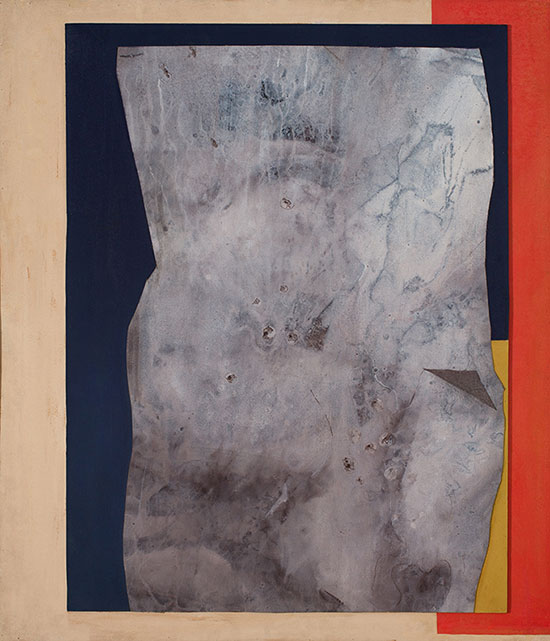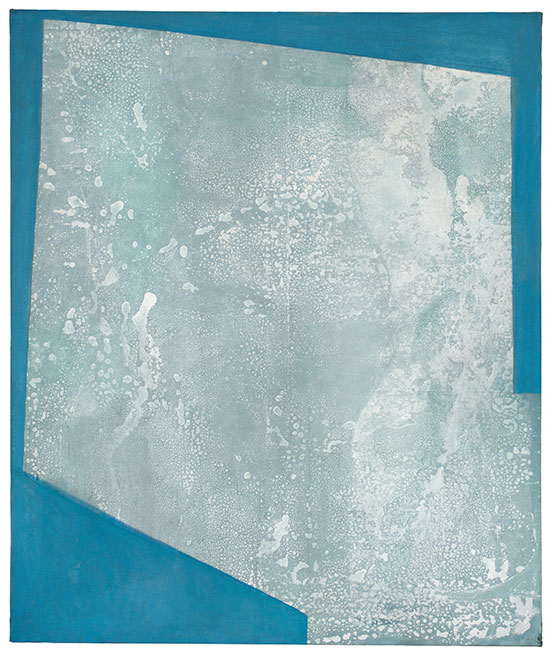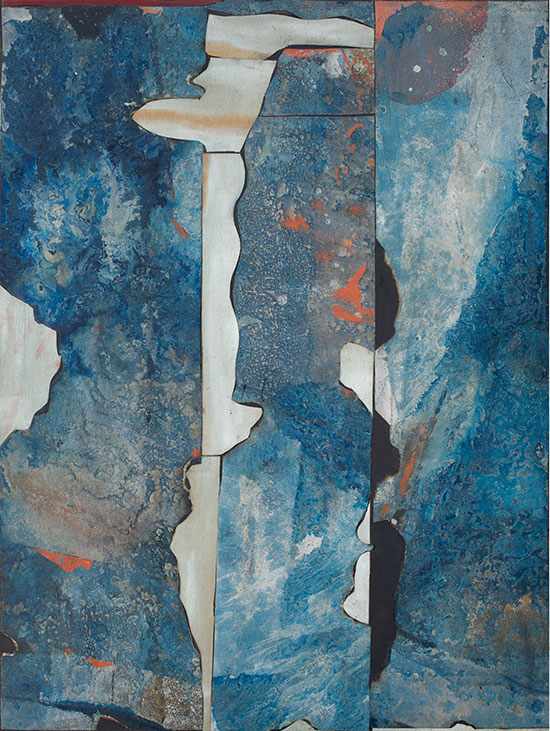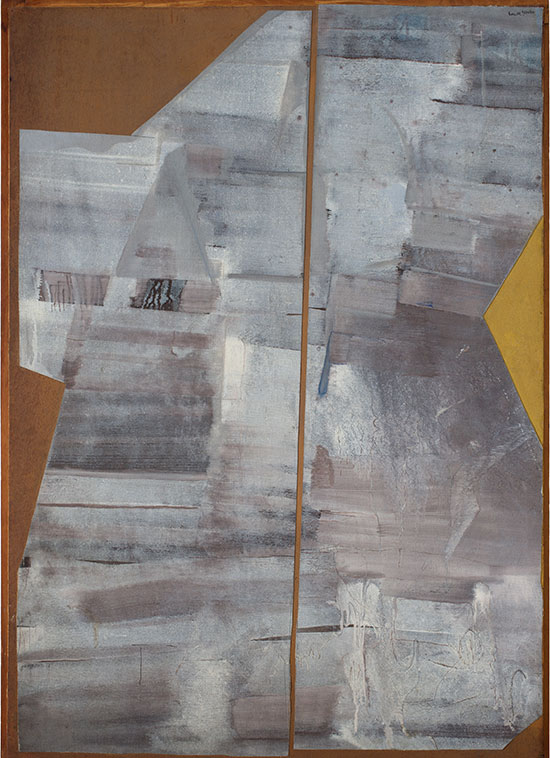PURCHASE, NY - “Romare Bearden: Abstraction,” currently on view at SUNY Purchase’s Neuberger Museum of Art in Westchester County, brings to light a sampling of work from an interesting moment in Bearden’s long career, work that had been nudged aside by an enthusiastic embrace of his later collages.
Despite the obvious influence the civil rights movement had on the public’s regard for his celebrated later efforts, the accolades he received for the collage work—if a lack of interest in what preceded it is any indicator—seemed to have followed the pattern set by the critical reception of the AbEx movement. Filtered through a popular meme of the war years embodied in the term “breakthrough,” this kind of critical response carries implications of protracted struggle followed by victory and forward advance.
Though not the stated thesis of the show, the Neuberger exhibition, in providing some context to the abstract period of the 1950s and early 1960s, brought this reviewer to the conclusion that this lingering idea of his success as a breakthrough makes a poor fit to the Bearden story, a realization that in turn informs my reading of his abstractions. Because Bearden’s career appears, even in the limited scope of this exhibition, a steady and consistent affair that holds to narrative and figurative concerns over many decades, it follows that any formal innovation he experimented with was always underscored by this broader vision. The key to understanding his abstraction, then, is to see it as an anomaly, yet executed with a consistent enthusiasm for the visual world and for social experience.
.

"Firefly" by Romare Bearden, c. 1960. Oil, canvas, and paperboard mounted on paperboard, 46 x 39 ¾ inches. Estate of Nanette Bearden, Courtesy of DC Moore Gallery, New York. © Romare Bearden Foundation/ Licensed by VAGA, NY Photography by Steven Bates.
.
In the hardcover volume that accompanies the show, curator and Neuberger Director Tracy Fitzpatrick writes that Bearden’s large abstract canvases, though inspired to some degree by the mid-1950s AbEX/color-field overlap, were also his initiation into oil painting. Prior to this series, he had worked in watercolor, gouache, collage and many other mediums. Most significant is the fact that Bearden was compelled during this transition to seek the counsel of a man we know only as Mr. Wu, a bookseller on Bayard Street near Bearden’s Canal Street studio, with whom he studied the tenets of Chinese ink painting, particularly as applied to landscape.
That Bearden would seek advice from someone whose knowledge ran wider than Western art and deeper than the current theory of the day is indicative of his need to anchor the vagaries of spontaneity and chance with his subject, which was essential to his vision. The spirit of the Harlem Renaissance and its emphasis on social experience had been a large part of his outlook since his teens. So it is no surprise that regardless of how ethereal these abstractions became, Bearden was always thinking of the human connections that informed his reading of these mysterious images.
Unlike his AbEX colleagues, most of whom were of the generation born between 1900 and 1920, Bearden’s goal was never to reinvent painting, but to use what was available in the expanding modernist lexicon to extend the parameters of an inclusive cultural vision. A canvas like Mountain of Heaven, 1961, illustrates how Bearden was indeed an experimenter, but not in the iconoclastic sense of the AbEx group, nor in the Greenbergian formal sense favored by the younger color-field painters.
Combining oil and turpentine washes with water-based casein, Bearden renders a rich surface of earthy color, mottled with crater-like ellipses that are apparently the result of the oil’s resistance to water. The surface demonstrates that it is not a gestural image, nor an essay in color, but the creation of a complex texture that suggests any number of readings. The most compelling of these takes its cue from the title, a spiritual trope that appears in this specific textual form in European and Central Asian cultures and, generally, in others too numerous to mention.
Bearden’s abstract canvases are of their time, yet set apart in ways that prove crucial to understanding their significance as a stage in the artist’s development. They differ from those of his contemporaries not only in their overt references to landscape, but in their reliance on a palette in the lower keys. In fact New Mountain, 1961 is not just earthy but monochromatic. It resembles the work of his contemporary Antoni Tàpies in its evocation of geological upheaval, but without the literal materiality Tàpies preferred.
More significantly, it suggests a layering of episodic moments separated by abrupt edges, which apparently reminded him of collage. For he soon evolves to cutting and re-assembling his poured remnants onto hardboard surfaces. In With Blue, 1962, he masks the canvas irregularly at the edges, repainting the outer sections a greyish blue. In others, like River Mist of the same year, he increases his cutting and rearranging, forming compositions that rely less on the pouring techniques and more on placement. And again, no surprise, these experiments begin to resemble figures, notably in Untitled 1962.
.

"With Blue" by Romare Bearden,1962. Oil and pencil on linen, 50 x 52 inches. Private Collection, Courtesy of DC Moore Gallery, NY © Romare Bearden. Foundation/Licensed by VAGA, New York, NY.
.

"River Mist" by Romare Bearden, 1962. Mixed media, 54 x 40 inches. The Romare Bearden Foundation, Courtesy of DC Moore Gallery, NY © Romare Bearden. Foundation/Licensed by VAGA, New York, NY.
.
The inclusion of a few classic Bearden collages, installed in the same gallery space as the undated Untitled (multicolor stripes), complete the story of a painter who arrives at his signature work through the slow meandering that defines most artist’s lives. Like most artists, Bearden could have been swept along by the abstraction of the 1950s, drawn as many were to the excitement at the heart of what helped New York emerge as an international art center. But it seems he moved instinctively back to the stream of ideas that had inspired him since 1933, when he drew political cartoons for “The Crisis,” a publication of the NAACP.
Today, many contemporary abstract painters have abandoned the strict formalism that dominated mid-century painting, seeking a confluence of abstract and representative imagery. Bearden’s foray into abstraction, sampled in this exhibition, offers a fascinating look at an artist working through the same issue a half century ago.
.

"Silver Gate" by Romare Bearden,1962. Mixed media, 52 ½ x 37 3/8 inches, The Estate of Nanette Bearden, Courtesy of DC Moore Gallery, NY © Romare Bearden. Foundation/Licensed by VAGA, New York, NY.
.
_______________________
BASIC FACTS: “Romare Bearden: Abstractions” is on view September 10 to December 22, 2017 at the Neuberger Museum of Art, Purchase College, State University of New York, 735 Anderson Hill Road, Purchase, NY 10577-1400. www.neuberger.org
________________________
Copyright 2017 Hamptons Art Hub LLC. All rights reserved.
